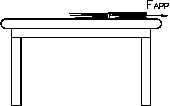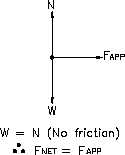FORCE EQUILIBRIUM
Application of Newton's Laws
CP-04
Page 12
Rev. 0
Figure 5 Net Force
The book remains stationary resting on the table because the table exerts a normal force upward
equal to the weight of the book. Therefore, the net force on the book is zero. If a force is
applied to the book (section B of Figure 5), and the effect of friction is neglected, the net force
will be equal to the applied force, and the book will move in the direction of the applied force.
The free-body diagram in section C of Figure 5 shows that the weight (W) of the book is
canceled by the normal force (N) of the table since they are equal in magnitude but opposite in
direction. The resultant (net) force is therefore equal to the applied force (F
).
APP
Equilibrium
Since an object in equilibrium is considered to be in a state of balance, it can be surmised that
the net force on the object is equal to zero. That is, if the vector sum of all the forces acting
on an object is equal to zero, then the object is in equilibrium.
Newton's first law of motion describes equilibrium and the effect of force on a body that is in
equilibrium. That law states "An object remains at rest (if originally at rest) or moves in a
straight line with a constant velocity if the net force on it is zero." Newton's first law of motion
is also called the law of inertia. Inertia is the tendency of a body to resist a change in its state
of motion.





